Risk Management and Trade Criteria– Crypto Academy / S5W7- Homework Post for @reminiscence01
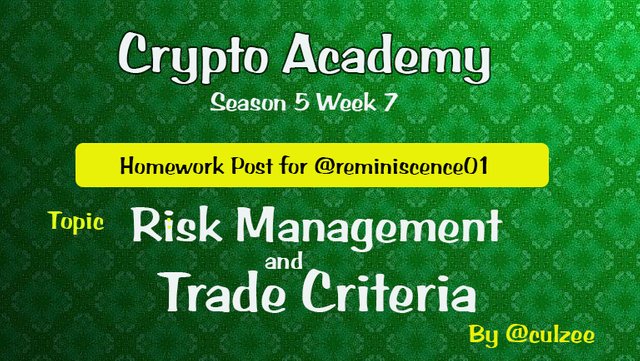

Hello everyone,
It's another wonderful privilege to learn more about cryptocurrency trading. Honestly, sacrificing for this academy is not a waste of time and effort. To me, it is a long term investment.
I have studied the lecture note and have grabbed the knowledge. For this reason, I write to share my understanding of the topic.

1. What do you understand by "Risk Management"? What is the importance of risk management in Crypto Trading?

Cryptocurrency market is known to be highly volatile and very risky. In cryptocurrency market, price movement is always uncertain and traders can not be 100% sure of the next price direction, even when several technical indicators or strategies are used.
With the advancement in technical analysis, traders who do not put risk management into consideration still trade at a loss. Many cryptocurrency traders and investors have suffered great loses as a result of poor risk management.
What is Risk in cryptocurrency trading?

Risk in cryptocurrency trading refers to the degree of uncertainty in the cryptocurrency market and the potential loss that a trader can encounter when he enters a wrong trade as a result of wrong market prediction. It has to do with market trend going against a trader's prediction.
Meaning of Risk Management in cryptocurrency trading

Risk Management in cryptocurrency trading refers to the process of using risk management tools to identify, assess and control uncertainties or potential loses to the barest minimum and to maximize profit.
In other words, it refers to planning and setting up a trade using risk management tools such as Take profit, Stop Loss, Position Sizing (eg. 1% Rule) and Risk Reward ratio to minimize loss and maximize profit.
Risk Management can also be seen as the ability to forecast market trend and to control possible loses from unsuccessful trading.
Cryptocurrency market is a highly profitable venture, but traders run into great loses when they fail to properly apply effective risk management strategies to control and minimize risks that happens as a result of negative effect of the market volatility.
Obviously, cryptocurrency traders some times experience loses, but if risk management is proper used, the trader's loss will be minimal and will not affect large portion of their trading capital.
Poor risk management has led so many traders to great loses. As traders, it is not good to rely only on the signals we got from technical analysis to make successful trading. We need to adhere strictly to proper and good use of risk management techniques.

What is the importance of risk management in Crypto Trading?

Risk management in Crypto Trading is vital. Below are some importance of risk management in Crypto Trading;
It helps trader to control loses.
Risk management enables traders to control the amount of loss they will incur if market trend goes against their prediction. For instance, if a trader enters a trade without using risk management tool like Position Sizing (eg. 1%, 2% or 3% Rule), Take profit and Stop Loss, when the market goes against his prediction, the trader will experience a heavy loss that can even wipe out the entire fund in his trading account. But if risk management is properly used and the market goes against the trader, the system will automatically close the trade at the specified stop loss and take profit level and exit trade. The trader can only incur a very minimal loss.It enable traders to maximize profit
Risk management is trader's ability to predict and control possible losses from an unsuccessful transactions. When this strategy is properly used, it will help traders to maximize profit as they reduce the risk of potential losses.It gives traders confidence and peace of mind
A trader who understands risk management techniques and can use them very well can confidently enter a trade and go to sleep. This is because, he is aware that even if the market goes against his prediction, that the system will automatically close and exit the trade at his specified stop loss (the amount he is willing to loss) and take profit ( the amount he is willing to make as a profit in a trading position) level.It helps traders to reduce fear and psychological trauma
Risk management helps traders to reduce the fear and psychological trauma that would arise as a result of uncertainty in the cryptocurrency market and the possible price reversal that may turn against their predictions and causing them a huge loss.It protects and saves traders from having O trading account balance
Risk management enables traders to risk a little percentage of their trading capital. This protects and saves traders' trading account from being brown out when a trade is unsuccessful.

2. Explain the following Risk Management tools and give an illustrative example of each of them. (a) 1% Rule. (b) Risk-reward ratio. (c) Stop loss and take profit.

As I mentioned in question 1 above, risk management is setting up of a trade using risk management tools to minimize loss and maximize profit. In this section, I will be explaining the three major risk management tools we need to make a successful trading.
Below are the risk management techniques with illustrative example of each of them.

(a) 1% Rule

This is a very important risk management tool traders should consider when trying to manage risk in cryptocurrency trading. This tool is used to prevent trader's account from blowing up in a single unsuccessful trade.
1% Rule saves traders from losing their entire trading capital when the market turns against their prediction. This rule enables traders to set or fix their trading account balance to 1% to enable them properly manage their risk without worrying of losing the entire fund in their trading account.
Experience traders do not risk 100% of their trading capital on a single trade, instead they risk at least 1% or at most 3% of their trading capital. The reason is because it helps save their account from total brow up when market trend goes against them.
An illustrative example of 1% Rule
If all I have in my trading account balance is $500. This amount is my 100% trading capital. If I enter a trade without 1% or any other Rule and the market goes against me, the whole money in my account might be wiped out in that single trade.
Experienced and professional traders can not make this mistake because it can lead to an overwhelming huge loss.
Instead of risking the entire money in my trading account, I can decide to risk just 1% of the trading account balance.
1% Rule means using only 1% of the entire money in my trading account to enter a trade. So, instead of risking the entire money in my trading account, I can risk 1% of the amount to enter a single trade.
This means that what I am risking is 1% of my $500 trading account balance which is 1% x $500.
Mathematical calculation
1% of $500
= 1/100 x $500
= 0.01 x 500
= $5.
With this calculation, what I am risking is $5 out of the $500 I have in my trading account. If I enter a trade with this rule and the market goes against me, the amount that will be affected in the whole money in my account will be only $5. The other remaining $450 will be protected and saved.

Risk Reward Ratio

This is another important risk management technique that experienced and professional traders use to minimize losses and maximize profits in cryptocurrency trading.
Risk Reward Ratio is a risk management that is used to measure potential profit and possible loss in cryptocurrency trading.
Risk reward ratio has to do with a trader knowing the position of his or her stop loss and take profit. This risk management tool is vital because a succeeding trading position in cryptocurrency market can reverse any time and if proper risk reward ratio is not set, the market trend may turn against the trader turning his or her profit into loss.
Risk Reward Ratio should be determined and properly setup before clicking order. In setting up Risk Reward Ratio, the risk ratio should be less than the reward ratio. In other words, the reward ratio should be greater than the risk ratio.
In our lecture this week, prof. @reminiscence01 recommended that reward ratio should be at least twice the risk ratio which is 1:2.
An illustrative example of Risk reward ratio
I have decided to risk 1% of my $500 trading capital which is $5 as I used in my illustration above. To apply 1:2 risk reward ratio, as my risk ratio is 1, my reward ratio should be twice the risk ratio or stop loss target of $5, which is $5x2 = $10.
This risk management tool is used to protect traders account from huge losses.

(c). Stop Loss and Take Profit

Stop Loss and Take Profit are risk management tools that traders use to automatically exit a trading position. In cryptocurrency trading, traders use stop loss and take profit to tell their broker when to close their opened trading positions.
Stop-loss is designed to let brokers know how much a trader is willing to risk in a trade with an instruction that the order should be closed once that position is reached.
While Take profit tells a broker how much a trader is willing to make as a profit in a trading position and orders that the position should be closed once the profit level is reached.
Stop loss and take profit are exit orders that are used by traders as risk management tool to protect their trading capital.
Stop loss is basically used to stop a trading position when the price action reverses and it is going against the trader.
When Stop loss is properly set, the order will be automatically stopped and closed when it gets to stop loss level.
On the other hand, take profit is designed to close a trade at a profit when the market price is going in the direction of the trader's prediction.
This is very necessary because if a trader is greedy and wants to take all the profit, the market that was in his favour may reverse and turn against him and he will begin to loose his gain. So, there is the need to take profit and leave the market until there is opportunity to enter another trade.
It is important to remember that cryptocurrency market is highly volatile. Traders should be aware that when entering a trade, that the market can go either in your favour or against your predictions.
So, before opening any trade position, ensure you setup your stop loss and take profit properly to avoid huge loss of your trading capital when the market goes against your favour.
Make sure that the stop loss you set is the amount you are willing to loose, in case the market price goes against your prediction. Also ensure that your take profit should be two times the stop loss, using the risk and reward ration as explained above.
Some major trading strategies where stop loss and take profit can be successfully placed are: trend lines, market structures, channels, support and resistance areas, as well as moving averages etc.
An illustrative example of Stop Loss and Take Profit
For easy and better explanation, I will like to use below screenshot for my illustration.
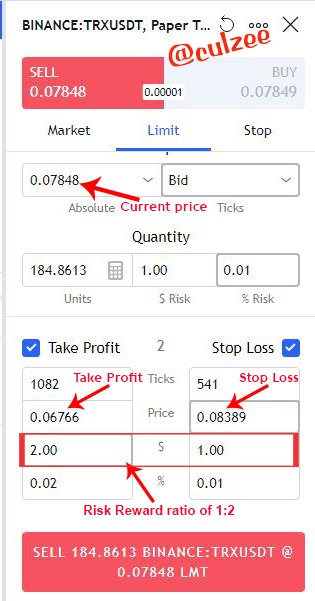
Screenshot from tradingview.com
This screenshot is a TRXUSDT sell order. As you can see, the current price is 0.07848 and this price is expected to be trending downward.
To place my sell order and apply Risk Management setup using risk reward ratio of 1:2, I set my Take profit at 0.06766 and my Stop loss at 0.08389.
What this means is that, I am predicting that the price will be coming down and as the price continues to go down I will be making profit.
Meanwhile, I am aware that because of the volatility in cryptocurrency market that the price can reverse at any time and start going up, against my prediction. If this happens, I will begin to loss my money.
So, what will I do, I need to instruct my broker that once the price reverses against my prediction of going down and starts going up, that as soon as the price gets to the stop loss price of 0.08389, that he should stop the trade and exit my order from the market.
On the other hand, if the price continues to go down in line with my prediction, that once the price reaches the take profit price of 0.06766 that I am ok with the profit, that he should close and exit the trade.

3.Open a demo account with $100 and place two demo trades on the following;(Original Screenshots on Crypto pair required). (a) Trend Reversal using Market Structure. (b) Trend Continuation using Market Structure.
The following are expected from the trade.
- Explain the trade criteria.
- Explain how much you are risking on the $100 account using the 1% rule.
- Calculate the risk-reward ratio for the trade to determine stop loss and take profit positions.
- Place your stop loss and take profit position using the exit criteria for market structure.

As prof. @reminiscence01 has given us go ahead to use any demo account size and apply the 1% rule if getting a $100 account will be a problem. I have a demo account size of $10, 000 and I will be using it in this section.
Here, I will be placing two demo trades on Trend Reversal using Market Structure and Trend Continuation using Market Structure. I will also discuss different trading criteria and how to set "Stop Loss" and "Take Profit" positions.

Trend Reversal Using market structure

The screenshot below shows a TRXUSDT bearish chart. As you can see, the price was making a series of higher highs and higher lows. Now, at the point where I marked with a small red circle, the price failed to create another high higher than the previous higher high and there was a price reversal, the price went downtrend breaking the market structure at the point where I indicated with big red arrow.
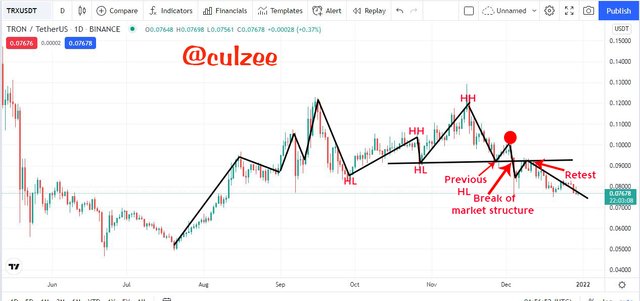
Screenshot from tradingview.com
Also, look at the point I indicated with small red arrow, the price retested the broken resistance line and turned support.

Entry Criteria for Selling opportunity

Criteria for Selling opportunity entry is a principle or standard a trader must consider before making decision to enter a selling trade.
So, before entering a selling trade:
- I ensured that the price has failed to create a new higher high that is higher than the previous higher high.
- I was patient to wait for the price to reverse going downward to break the market structure.
- I also waited for the price to retest the broken low to form a resistance.
- And then executed a selling trade after a bearish engulfing candlestick shows up.

Exit Criteria for Selling Opportunity

Exit criteria for selling opportunity is a principle or standard a trader must consider before making decision to close the selling trade.
So, before closing the selling trade:
- I ensured that I placed my stop loss a little above the resistance line.
- I also ensured that I set my take profit target to the nearest support level using risk-reward ratio 1:2.
Below is the screenshots.
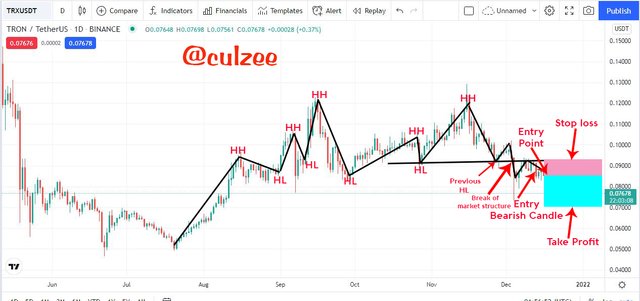
Screenshot from tradingview.com
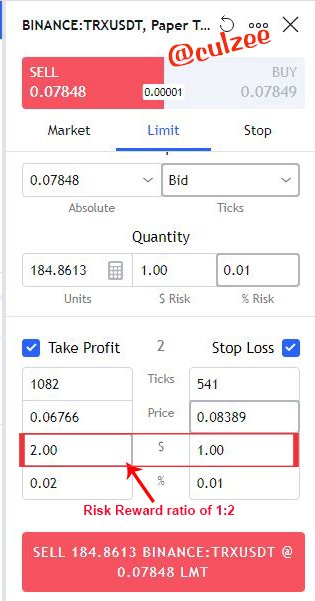
Screenshot from tradingview.com

Screenshot from tradingview.com

Calculate the Risk reward ratio to determine the stop loss and take profit

To calculate the risk reward ratio, I have a demo account of $10, 000 and it is my trading account balance.
I have decided to risk 1% of this account for my trading position. To calculate how much of this my trading account balance I will loss if the market goes against my prediction, we have:
1% x $10, 000
= 1/100 × $10, 000
= 0.01 × 10,000
= $100
This means that I will be losing $100 out of the $10, 000 I have in my trading account balance, if the market goes against my prediction.
To calculate how much profit I will make if the market goes according to my prediction using risk reward ratio 1:2, we have:
2% x $10, 000
= 2/100 × $10, 000
= 0.02 × 10,000
= $200
This means that I will be making profit of $200 if the market goes according to my prediction.
Now, I placed a sell entry at the entry price of 0.07848, take profit at 0.06766 and stop loss at 0.08389 using risk reward ratio of 1:2.
Few hours after the transaction was executed, the trade started making profit. As you can see on the below screenshot.

Screenshot from tradingview.com
The transaction is still running as at the time of making this post.

Trade Criteria for Trend Continuation Using Market Structure

Entry Criteria
For buying opportunity
- First identify the market direction. Make sure you determine whether the market is going upward creating higher highs and higher lows, or whether the market is going downward creating lower highs and lower lows.
- If the trend is bullish, that is going upward, make sure price retraces to form a higher low higher than a previous low.
- When the price reverses and starts going up with a bullish engulfing candlestick, then you can enter a buying trade.
For selling opportunity
- If the trend is bearish, that is going downward, ensure that the price retraces to form a high lower than the previous high.
- When the price reverses back down with a bearish engulfing candlestick, Then enter a sell position.
Exit criteria
For buying opportunity
- Ensure that your Stop loss is placed below the low point
- The Take Profit should be double the stop loss with risk-reward ratio of 1:2
For selling opportunity
- Ensure that your Stop loss is above the lower high
- The Take Profit should be double the stop loss with risk-reward ratio of 1:2
Below is the screenshot of my buy trade criteria for Trend continuation.
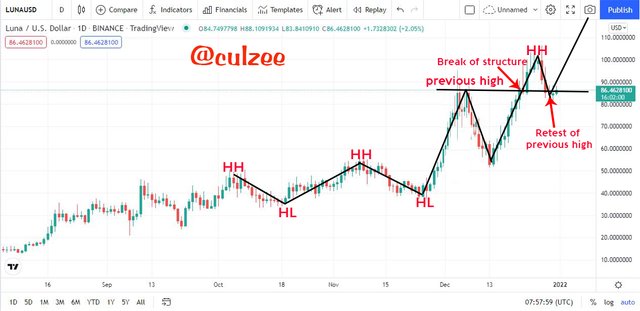
Screenshot from tradingview.com
The above screenshot shows a LUNAUSD bullish chart. As you can see, the price was making a series of higher highs and higher lows which is a bullish trend. At a point I indicated with bigger arrow, the price retraced and formed a low that is higher than the previous higher low.
Then, I entered a buy position when I noticed that a bullish engulfing candlestick pattern has started forming upward.
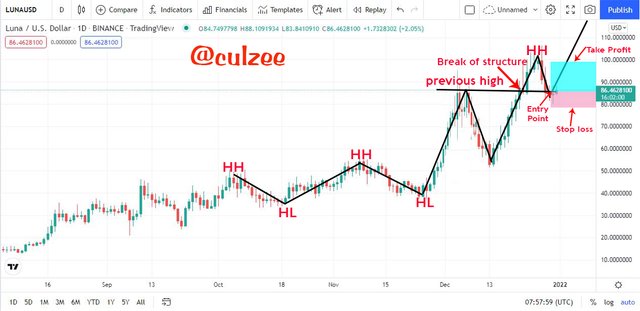
Screenshot from tradingview.com
Calculating the Risk reward ratio to determine the stop loss and take profit

To calculate the risk reward ratio, I have a demo account balance of $10, 000 and it is my trading account balance.
I have decided to risk 1% of this account for my trading position. To calculate how much of this my trading account balance I will loss if the market goes against my prediction, we have:
1% x $10, 000
= 1/100 × $10, 000
= 0.01 × 10,000
= $100
This means that I will be losing $100 out of the $10, 000 I have in my trading account balance, if the market goes against my prediction.
To calculate how much profit I will make if the market goes according to my prediction using risk reward ratio 1:2, we have:
2% x $10, 000
= 2/100 × $10, 000
= 0.02 × 10,000
= $200
This means that I will be making profit of $200 if the market goes according to my prediction.
Now, I placed a buy entry at the entry price of 89.1, take profit at 91.126 and stop loss at 88.126 using risk reward ratio of 1:2.
See the screenshot below.
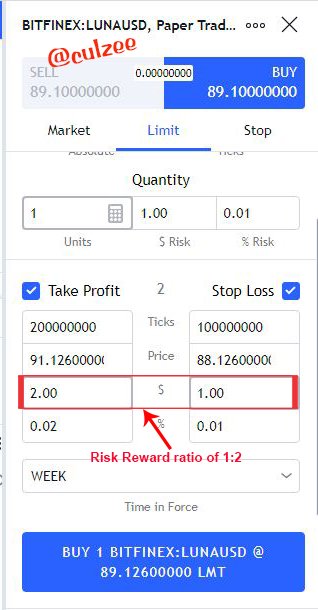
Screenshot from tradingview.com

Screenshot from tradingview.com
The transaction is still running as at the time of making this post.

Conclusion

The cryptocurrency market is known to be highly volatile and very risky. Risk management is very important aspect of cryptocurrency trading that should not be neglected.
In this home work, I have been able to explain what Risk Management means in detail and its importance in Crypto Trading.
I have also explained three risk management tools which includes 1% Rule, Risk-reward ratio, Stop loss and take profit with illustrative example of each of them.
Finally, I opened a demo account placing trades on Trend Reversal using Market Structure and Trend Continuation using Market Structure.
This is a wonderful learning experience. I sincerely want to appreciate our amiable lecturer, @reminiscence01 for this powerful and wonderful knowledge.
Thank you so much.
Hello @culzee, I’m glad you participated in the 7th week Season 5 of the Beginner’s class at the Steemit Crypto Academy. Your grades in this task are as follows:
Observations:
That's correct.
Correct.
Recommendation / Feedback:
Thank you for submitting your homework task.